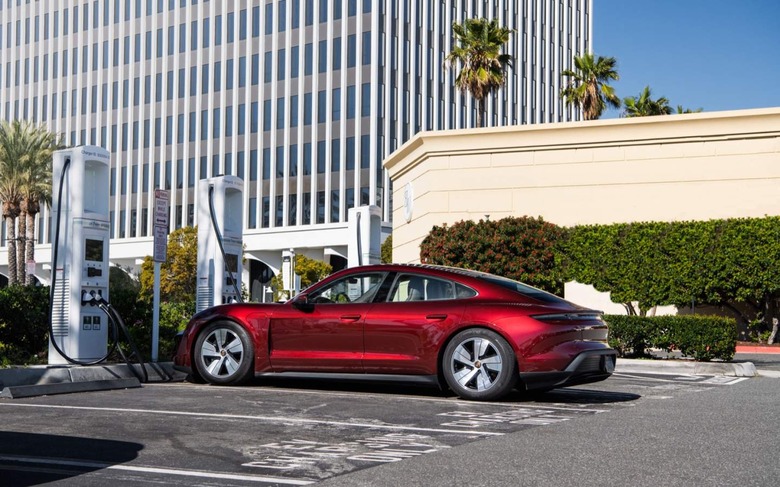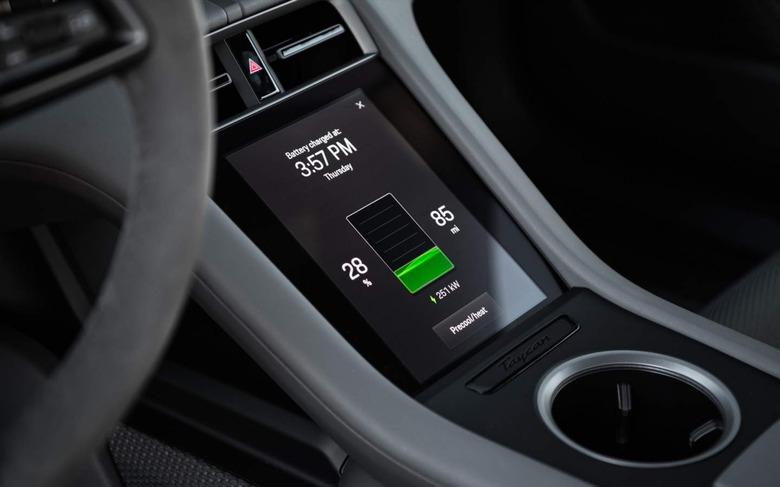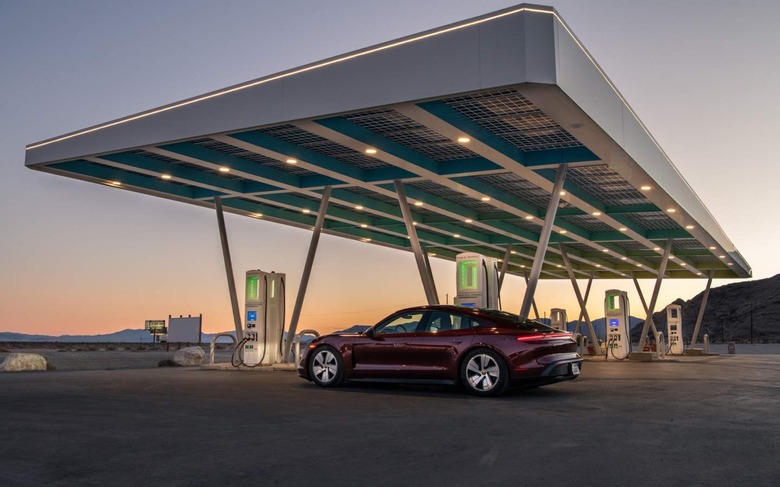Porsche Just Set An EV World Record - And It Highlights A Big Charging Issue
The Porsche Taycan has set a new Guinness World Record, with a cross-country drive seeing the EV go from coast to coast in the US with under 2.5 hours of charging stops along the way. It's a sign of how far public electric vehicle infrastructure has come on in recent years, though also a reminder that there's more to EV ownership than simply where you can plug in.
The route itself was straightforward: from Los Angeles, CA all the way to New York City, NY on November 12, 2021. In total, the Taycan drove 2,834.5 miles, Porsche says, with driver Wayne Gerdes pausing at 18 different charging locations for a cumulative total of 2 hours, 26 minutes, and 48 seconds. That's an average of around 157 miles per charging session. The previous record stood at 7 hours, 10 minutes, and 1 second.

The car itself was a 2021 Taycan with the Performance Battery Plus, which is EPA rated for 225 miles of range. The automaker says it made no special customizations to the EV, though it was equipped with the regular Premium Package, Adaptive Cruise Control, and Porsche Electric Sport Sound.
The Taycan and the EPA have had a rocky relationship since Porsche launched the EV in the US. While initial estimates for the electric sedan's battery were reasonably high, by the time it had gone through the test cycles for the US Environmental Protection Agency, the range number proved to be unexpectedly low. Porsche pushed back with independent testing which, it argued, not only got a higher range figure – in excess of 280 miles, in fact – but better represented typical use, but was still forced to publicly disclose the official EPA number as it markets the car.
Since then, we've seen an uptick in range – not least with Porsche debuting a more affordable Taycan model without all-wheel drive – but the car still falls well short of what rivals like Tesla are offering, at least on paper. Porsche's argument, beyond the results of its independent testing, has always been that charging speed is as important, or more so, than total range. That, though, has proved more difficult to market.
EV charging has a lot of variables
For a start, not all electric vehicles can charge at the same rate. That depends on the hardware fitted to the EV itself, the charger hardware, and other factors including the current state of charge of the vehicle when it's plugged in.

In the case of the Taycan, the electric sedan supports up to 270 kW DC fast charging. For that, you'll of course need a charging station capable of those rates, which some – though not all – of Electrify America's chargers can deliver. The charger provider currently supports up to 350 kW rates on select units.
However, the so-called charging curve also makes a big difference. Porsche says that the Taycan can go from 5% to 80% state of charge in around 22.5 minutes, with a suitably potent DC fast charger. Beyond 80%, though, the rate drops significantly, in part so as to avoid damaging the battery's long-term health.
Getting the best charge while you're mid-journey, then, isn't just about figuring out where to top up, but when. For Porsche's record attempt, for example, one 6% to 82% recharge took a quoted 22 minutes on a 350 kW Electrify America charger. Keeping going from 82% to fully charged, however, would have taken considerably longer than that.
Fast charging is great, assuming it works
The cloud hanging over all of this is charger network reliability. Porsche says that Electrify America was aware of the record-setting attempt's route, and the charging locations that the Taycan was scheduled to arrive at. However it insists that nothing beyond normal maintenance work was done at those locations.
How familiar an experience that is for EV drivers may well vary. Opting for public charging infrastructure rather than building out its own network – Electrify America is funded by Volkswagen Group, which owns Porsche, but operates as an independent business – means Porsche saved the time and expense of replicating Tesla's Supercharger investment. It also leaves Taycan owners at the mercy of third-party maintenance.

Chargers that are out of order when drivers arrive, which don't recognize payment methods or membership accounts, or which simply don't hit the charging rates that they – in theory – ought to are all complaints regularly leveled at public charging networks. In our own experience with the 2022 Taycan GTS recently, for example, the EV proved capable of adding an estimated 6.5 miles of range per minute plugged in at an Electrify America station. That's impressive, but it's also worth noting that the chargers at the next bay over were broken.
In short, when they're working, the experience of using DC fast chargers can be great – especially when paired with an EV that's capable of taking full advantage of their potency. It doesn't take much, though, to ruin that experience, and potentially leave owners questioning whether their electric cars are reliable enough to leave combustion engines behind completely.
Fast charging is about more than just roadtrips
While this new record is, on the face of it, a reminder that electric cars aren't out of their depth when it comes to long distance journeys, DC fast charging has arguably a more important role in EV adoption. Currently, the bulk of charging for an EV is carried out either when the car is parked at the owner's home or their workplace. Yet urban electrification to rise in popularity, a solution to the absence of private or dedicated parking needs to be found.
Those in cities who may need a car, but can't guarantee they'll always be able to park it in the same spot – or a location within safe reach of a charger – typically find themselves left out of EV ownership. That, according to some development plans, is where DC fast charging comes in.
Rather than leaving an EV plugged into a Level 2 charger for the typically 8+ hours they require to recharge at home, EV drivers with access to more DC fast charging – and the cars that support those rates – could theoretically top up for their weekly needs on a more ad-hoc basis. For that to be feasible, though, it'll require a greater investment in urban charging locations, and vehicles that can take advantage of them. The goal, in many cases, is to make the speed to an 80% charge much the same as filling up a gas tank would be.
